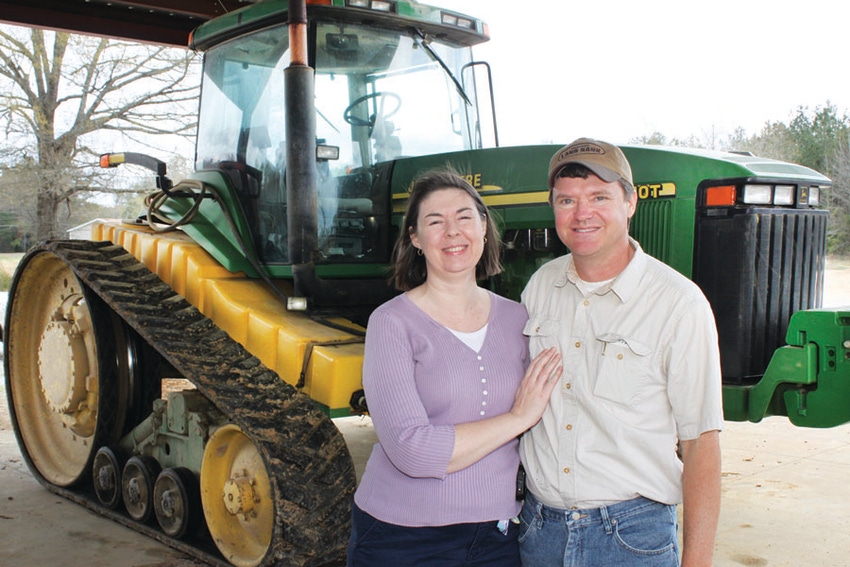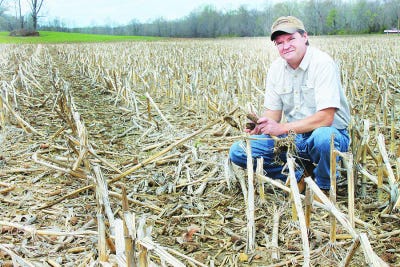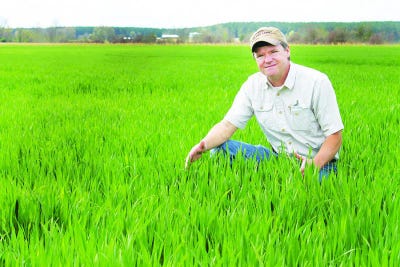
Knowledge he gained from Mississippi State University Extension management programs and specialists, from production conferences, and from farmers willing to share their experience and advice, has led to the adoption of practices that boosted yields, reduced costs, and increased revenues on Keith Morton's north Mississippi farm.

If you want testimony about the ups and downs of farming, talk with Keith Morton. He’s got firsthand experience with both — starting with the downs.
“In 1995, in my early adult farming years with my father, Billy Morton, the tobacco budworm nearly put us under,” he says. “Our cotton yield was 160 pounds. Then followed back-to-back dry years in 1998-99, with more poor yields. Dad was coping with health problems and wasn’t actually participating in the farming operation. We were in survival mode, and I had to do a lot of soul-searching as to whether I would even try to continue farming.
“If I stayed in it, I knew I had to make some changes, had to increase efficiency, find ways to become more productive and increase revenue.”
That he’s still farming today and doing well, Keith says, is a credit to his wife, Beth, “whose strong faith led me to a newfound faith of my own and a realization that this is what God meant for me to do and that with His help I could succeed.”
And he says, knowledge he gained from Mississippi State University Extension management programs and specialists, from production conferences, and from farmers willing to share their experience and advice, led to the adoption of practices that boosted yields, reduced costs, and increased revenues.
“No-till seemed to be one way to start changing things,” he says. “I attended the No-Till Cotton, Soybean, and Rice Conference at Tunica and met a number of experienced farmers who were generous with tips and advice. After that, it was baby steps — changing a practice here, adding something there, always looking for ways to do things better and cut costs.
“Beth happened on an article about the Mississippi Extension SMART program (Soybean Management by Application of Research and Technology), which links farmers with researchers, Extension specialists, and county agents to better manage soybean fields for increased profits.‘We’ve got to sign up for this,’ she said. We were able to start it in 2000, and it has helped us achieve a huge increase in soybean yields. I credit this program with putting me on the road to profitability.”
Keith and Beth (his father died in 2003) now farm 1,000 acres of row crops near Falkner, Miss., and he says the move to no-till, along with improved varieties, helped with his goal to boost crop yields.
“I’ve followed Extension recommendations on fertility, and have moved to variable rate soil sampling and lime/fertilizer applications. Early planting has been another big plus. I’ve planted soybeans as early as March 25 — and actually got snow on the field before they emerged. But that 23-acre test field yielded 74 bushels. That got my attention!
“In this area, on our soils, April 10-15 is when we’d like to be planting, but this year, frequent rains kept us out of the field [as of May 6, he was still waiting to start planting due to wet, cold soils]. I don’t like to plant when a hard rain is predicted, and if I’m planting I’ll stop two or three days before a predicted big event. We had a low of 35 degrees and frost April 25, but fortunately wheat hadn’t headed out yet and wasn’t damaged. In 2008, I wasn't able to plant until May and June, but still had an excellent crop."
Slowing planter helped stand uniformity

RESIDUES from the previous year’s crops help to build soil tilth on Keith Morton’s Tippah County, Miss. farms.
Admitting that “I once was a very impatient person,” Keith says, “As I’ve grown older, I’ve more and more learned the value of patience. I still want to use my time as effectively as possible, but I don’t want to get in such a hurry that I mess up something and have to redo it. I want every row I plant to be as good as it can be. When I make a pass across the field, I want that row to be in the optimum condition to make the highest yield possible.
“One change that has been really beneficial was to reduce planter speed. I used to run at 6 mph — now I go at 4 mph to 4.5 mph, and it has made a difference in more uniform stands.
“When I was doing conventional tillage, I was running three tractors with three operators, burning an awful lot of diesel and wearing out a lot of bearings and blades. I started transitioning to no-till in 2000, and the savings in time, equipment use, and fuel was significant. And it was a good fit with our goal of planting early.
“The benefits have been cumulative — each year gets progressively better. I can’t document it, but I can see the improvement in the soil from all the decaying residues; it just has better tilth. There are still instances when I feel it’s necessary to till — if I need to establish a bed in a new field, for example.
“I’ve been experimenting, on a small scale, with a bed system that I’d been thinking about for a long time. It requires tillage at the start to establish beds and then I go to permanent no-till with controlled traffic.”
Subscribe to Delta Farm Press Daily.
Soils are Collins silt loam and falaya loam, Keith says, and all but a couple of fields are bottom land. “I’ve been doing grid sampling and applying variable rate lime since 2004. Initially, my custom fertilizer applicator had a single bin truck, so we couldn’t do P and K applications independently. They got a multi-bin truck in 2010, and can now do variable rate applications.
“I sample every three years and use yield monitor data to determine application rates in non-sampling years to replace nutrients removed by the previous year’s crop.
“Since I’ve been doing variable rate lime applications, I’ve been seeing more stability in pH levels, and am now having to add less lime. At the same time, yields have been consistently increasing, particularly for soybeans. I used to see stunting of plants in low pH areas — now the crop is much more uniform and healthy, and yields are more stable. I hope to be able to achieve the same sort of improvement with corn.
“I do my best to stay on a rotation program. I’m constantly looking for any advantage I can find to improve my fields and my overall operation. When I finish each year, I evaluate everything I’ve done, and I try to find at least one thing I can do better next year.
“I’ve been able to add acres by renting some land that had been out of crops for 15-20 years. Some of it wasn’t the best of land, but I’ve been able to improve it and turn it into good, productive crop land.”
Implementation of conservation practices
He continually seeks ways to enhance his conservation efforts, Keith says. “I utilize filter strips, grass waterways, and other measures to slow or stop nutrient runoff and to keep all the money I spend on fertilizer on the farm instead of washing away.
A PLANTING SYSTEM is being evaluated in which Keith Morton has two 26-inch rows on a 60-inch bed, with 34 inches between rows where the tractor wheels run.
“This year, I joined REACH (Research and Education to Advance Conservation and Habitat), it’s goal is the creation of a network of cooperative farms with a variety of agricultural practices to illustrate the success of conservation practice implementation on landscape stewardship, while encouraging profitable and sustainable production systems. (reach.msstate.edu)
“REACH coordinator Robbie Kroger is helping me set conservation goals for my farm and a roadmap to achieve those goals. This year we are working with Avail, a product that’s added to fertilizer to make it more effective. We’re comparing a 40 acre treated plot with a 40 acre untreated plot. Runoff will be caught and measured to see if Avail helps to keep more fertilizer on the field and if that additional fertilizer provides a yield benefit. This fall, we hope to put a cover crop test in place to see how cover crops might fit in a long term no-till system.”
Keith says he “had always thought of myself as a cotton farmer, and until 2006 the farm was a bit over 50 percent cotton, the rest soybeans. Cotton was more dependable and I stayed on a cotton/soybean rotation. In 2007, I cut back on cotton acres, and 2008 was the first time in my lifetime there was no cotton on the farm.
“With the significant boost I had achieved with soybean yields, and rising prices for grains, cotton wasn’t the most attractive option. Also, I thought the operation would be more efficient without having to manage two production platforms.
“In 2010, when cotton prices were good, I planted it again, had good yields, and got a good price. In 2011, with cotton topping $1, I was able to contract early at $1.31-1/2. Had my father been alive to see that, he would have been amazed. I won’t have any cotton this year, however, and going forward will grow it only when I can see potential for a good profit.” His cotton is marketed through Staplcotn.
In 2012 as pricing opportunities for grains became even more attractive, for the first time in 10 years Keith added corn to his crop mix. “We had grown corn until 2002, but yields were very erratic and it wasn’t profitable. With no-till, improved varieties, and a lot more available research, it looked like a good option, so I planted 180 acres. Varieties were Pioneer 33N58 and 33N55 refuge, Dekalb 6469, and AgVenture RL9694HB (Bt) and R9795 (refuge).
“Last year was the first time I’d harvested corn with a yield monitor on the combine, and at harvest I could see a huge variability in the crop — some areas were yielding 230 bushels, while others were only 40. The overall average was 118 bushels, which I thought was good on non-irrigated land, considering that we had no rain June 10-July 10, with temperatures soaring to 100 degrees.
“At today’s prices, I can do OK with a 118 bushel average — but I believe there is potential to achieve much higher yields, and my goal is to find ways to do that.”
Wheat yield significantly improved
Keith added wheat in 2007, averaging 57 bushels. “It took a while to get to know the crop and to improve production methods,” he says. “I changed from 10 inch rows to 7.5 inch and increased plant population, and in 2012 yield was 73 bushels — a significant improvement.

WHEAT WAS ADDED to Keith Morton’s operation in 2007. Since then, he has increased yields from 57 bushels to 73 bushels through improvements in production/management practices.
“Wheat provides the benefit of providing cash flow in the spring. I have 450 acres this year, which will be double-cropped to soybeans, and I’ll have 370 acres of full-season beans. Soybean varieties are Pioneer 94Y90, Asgrow 4632, Armor DK4744, and AgVenture 51X.
“I also get some extra revenue from the wheat by contracting with a local landscape firm that comes in following harvest and bales the straw for use on highway rights-of-way and other projects where a lot of mulch is needed. And I lease hunting rights on my land, which provides additional income.”
Adding GPS technology in 2008 enabled him to achieve a greater degree of accuracy in field operations, Keith says, and to get more work done in less time.
“We added John Deere auto-steer, swath control, and yield monitoring all at one time, and it’s one of the best investments I’ve ever made. The only problem with my current GPS system is that I can’t get the repeatability I need to keep rows and tractor paths in exactly the same place. Positions drift over time.
“Next year, I plan to upgrade to RTK. With that technology, there is no drift — positions stay the same from day to day, year to year. It will also record elevation data, which will be useful in improving drainage. And if I install drip irrigation in the future, as I hope to do, repeatability will be necessary, particularly on irregularly-shaped fields.”
Keith’s tractor is an 8410T John Deere — a wide stance machine with 18 inch tracks, 120 inches track-to-track. “It spreads the weight of the tractor lengthwise instead of widthwise,” he says, “which results in less compaction. It has been an excellent fit for my bed system and controlled traffic. My no-till planter is a 12-row John Deere 7300. Residue cleaners on the planter push aside residue from last year’s crop just enough to provide a clean opening for seed placement.
'Never a wheel track on a bed'
A CLOSEUP of the beds, showing twin planting rows. Precision farming technology, with a move to RTK in 2014, will allow repeatability of beds and tractor tracks from year to year.
“I’m testing a system in which I have two 26-inch rows on a 60-inch bed, with 34 inches between rows where the wheels run. My John Deere 9400 combine also fits this placement, so with RTK all equipment tracks are the same from year to year and there’s never any compaction in the bedded areas. If I put spacers on my John Deere 9965 cotton picker, it would also fit this pattern, but I may trade pickers before I plant cotton again. My goal is to never have a wheel track on a bed.”
Keith says he’s looked into adding irrigation on some of his land, “But I’ve felt there were other improvements that I could make, at less cost, to boost yield. Long term, I expect I will add some irrigation. I’m told I’d have to go about 1,000 feet to get adequate water volume, so I’m considering building reservoirs to collect water for irrigation, perhaps a drip system.”
While there has been some documented Italian ryegrass resistance in the area, Keith says he has had no issues with it. “One year, on about 5 acres of a 120 acre field, I had some marestail and pigweed that survived burndown. I tilled the spot, planted LibertyLink soybeans and made two Liberty applications after planting. Control was excellent.
“I’ve been overlapping residuals in my burndown program, following the recommendations of Dr. Tom Eubank at the Delta Research and Extension Center. I do a fall burndown with Valor or LeadOff, and if I need to follow with any spring burndown prior to planting, I’ll add Canopy to Roundup; if not, I’ll add First Rate to the first over-the-top application.

RESIDUE CLEANERS push debris from the previous year’s crop to the side to allow creation of a clear slit for placement of seed.
“Since I’ve added a scout, I’ve had no real problems with insects, and I’ve probably sprayed less than 200 acres. This year’s wheat crop has been scouted for disease, but thus far none has been found. With any crop, I spray now only if the scout says to do so.
“As intense as I am about hands-on management, I had been doing my own crop scouting for 10 years. But I increasingly found that I needed more expertise, and that I could better utilize my time elsewhere. Southern Ag Consulting, which offers a broad range of services and expertise, now does my scouting. They also take my soil sampling data and develop prescriptions for variable rate fertility programs. And they maintain all my data and crop information in a central location for any kind of analyses I need, and for use in obtaining crop insurance.
“This has resulted in a significant time savings for me,” Keith says, “and has added a new level of efficiency to my management program. In farming, I’ve learned that timeliness is one of the most important factors in crop success, so I’ve sought out custom applicators and other custom services, looking for people who can do what I want done the way I want it done. Mid-South Co-op at Bolivar, Tenn., and Jimmy Sanders, Inc., at Ecru, Miss., do that — they pay attention to what they’re doing, and they do it right.
“This allows me to focus on what I need to be doing at critical times in the season. A neighbor, Matt Ormon, who has a larger combine and doesn’t grow wheat, helps me with wheat harvest, which allows me to be on the planter to get soybeans in the ground as quickly as possible behind the wheat.”
Keith says he stores none of his grain. “Everything is trucked out as soon as it’s harvested. I forward contract through ADM at Memphis and deliver at harvest.”
At last December’s Mississippi State University Row Crop Short Course, he says, “I heard a presentation by Mark Gold of Top Third Ag Marketing on the use of put options as part of a crops marketing strategy. A light bulb went off in my head — for the first time, I had an understanding of how this tool can work to help limit risk and insure profit whichever way the market turns.
“Their specialists helped me to develop a plan that allows me to market my expected full production without having to deliver 100 percent. I set up an account with them and I now have my 2013 production that isn’t forward contracted protected with put options. I can follow how things are going in real time on my computer or smart phone and see how it’s protecting me. It has given me a lot of peace of mind and allowed me to focus more on production.”
About the Author(s)
You May Also Like



